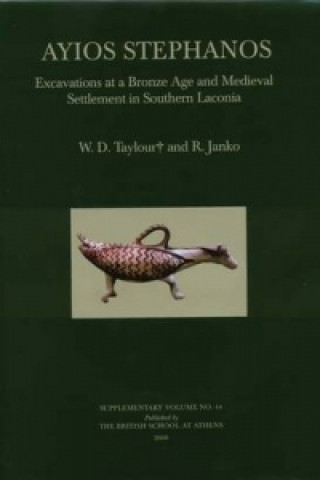
Kód: 04760219
Ayios Stephanos
Autor R. Janko, W.D. Taylour
Lord William Taylours excavations at Ayios Stephanos in 1959-77 investigated a port that relied on trade, fishing and metallurgy. It lay just north of the main Minoan east-west trade route via Kythera and exported the rare stone l ... celý popis
- Jazyk:
 Angličtina
Angličtina - Vazba: Pevná
- Počet stran: 710
Nakladatelství: British School at Athens, 2008
- Více informací o knize

Mohlo by se vám také líbit
-

Dune
216 Kč -

Haunting Adeline
621 Kč -

Berserk Deluxe Volume 2
1092 Kč -

White Nights
89 Kč -

Powerless
268 Kč -

Atomic Habits
330 Kč -

Dune Messiah
228 Kč -

Berserk Deluxe Volume 3
1142 Kč -

One Day
221 Kč -

Berserk Deluxe Volume 1
1115 Kč -

Iron Flame
368 Kč -

Surrounded by Idiots
213 Kč -

Harry Potter and the Prisoner of Azkaban (Minalima Edition)
993 Kč -

Gravity Falls Journal 3
443 Kč -

Heaven Official's Blessing: Tian Guan Ci Fu (Novel) Vol. 1
420 Kč -

The Creative Act
568 Kč -

Dune
276 Kč -

Hunting Adeline
624 Kč -

A Little Life
290 Kč -

Children of Dune
230 Kč -

Heaven Official's Blessing: Tian Guan Ci Fu (Novel) Vol. 2
427 Kč
Informovat o naskladnění knihy
Zadejte do formuláře e-mailovou adresu a jakmile knihu naskladníme, zašleme vám o tom zprávu. Pohlídáme vše za vás.
Více informací o knize Ayios Stephanos
 Anotace knihy
Anotace knihy
Lord William Taylours excavations at Ayios Stephanos in 1959-77 investigated a port that relied on trade, fishing and metallurgy. It lay just north of the main Minoan east-west trade route via Kythera and exported the rare stone lapis lacedaemonius to Cretan workshops. As a Linear A inscription shows, the site illuminates the diffusion of Minoan culture to the mainland. Ayios Stephanos yielded a stratified pottery sequence from EH I to LH IIIC, with a break at the end of the Early Bronze Age. Study of this sequence has vastly improved our knowledge of the chronology, clarifying Cretan relations with the mainland. There were three phases of EH. After disastrous fires, rectangular buildings replaced the MH I apsidal dwellings, and the street plan came to resemble Minoan prototypes. The pottery illuminates the invention of Mycenaen ceramics. In line with the fortunes of Crete, the site declined in LH IIA, traded with Knossos in LH IIIA1, and declined again. It briefly revived in LH IIIC Early, probably following an influx of refugees. Then it was abandoned, perhaps after a massacre. Ayios Stephanos was reoccupied in c. 1270 AD, when a building with a walled yard and stables was erected to guard the approach to Skala along the River Vasilopotamos. This phase fills a gap in our knowledge, since no site of this period has been excavated south of Corinth. After 1321 a hostile raid plunged the site into oblivion. This publication studies the architecture and stratigraphy, the burials, the Medieval period, the pottery and small finds, the human and other organic remains, the settlement pattern and the regional and historical context. Numerous figures and plates document the results. Appendices containing techinical analyses, stratigraphic tables and concordances are on an accompanying CD.
 Parametry knihy
Parametry knihy
Zařazení knihy Knihy v angličtině Humanities Archaeology Archaeology by period / region
- Plný název: Ayios Stephanos
- Podnázev: Excavations at a Bronze Age and Medieval Settlement in Southern Laconia
- Autor: R. Janko, W.D. Taylour
- Jazyk:
 Angličtina
Angličtina - Vazba: Pevná
- Počet stran: 710
- EAN: 9780904887587
- ID: 04760219
- Nakladatelství: British School at Athens
- Hmotnost: 2744 g
- Rozměry: 297 × 216 × 48 mm
- Datum vydání: 11. November 2008
Osobní odběr Praha, Brno a 12903 dalších
Copyright ©2008-24 nejlevnejsi-knihy.cz Všechna práva vyhrazenaSoukromíCookies



 Vrácení do měsíce
Vrácení do měsíce 571 999 099 (8-15.30h)
571 999 099 (8-15.30h)